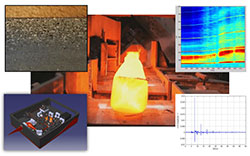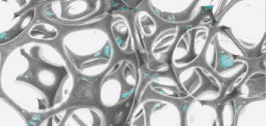Project 1.2

Laser ultrasonics as tool for microstructure characterization
The sub project 1.2 deals with the contactless detection and characterisation of defects as well as the analysis of microstructures in metals by Laser Ultrasound.
The main goal is to bring this technology and its applications from the laboratory into the industrial environment in order to secure the benefits for the industrial research partners. Read More: Laser Ultrasound is a non-destructive and contactless method, which allows the testing and characterisation of the following points:
- Detection and characterisation of defects inside and on the surface of components (e.g. crack detection, weld inspection, detection of inclusions,…)
- Testing of the geometry (e.g. sheet thickness,…)
- Characterisation of the elastic characteristics and the anisotropies (directional dependence on the elastic characteristics like Young’s modulus caused by forming processes such as hot rolling- or forging processes)
- Characterisation of microstructure (e.g. determination of the hardening depth or a change in the grain structure caused by forging processes)
Laser Ultrasound has the big benefit of being contactless, therefore it can be used directly in the production process, for applications on hot materials and components, where no couplant agent is allowed (because the residues can negatively influence the further processing). With Laser Ultrasound a „zero-defect-production“, which is required in many industrial sectors, is nowadays possible. On the one hand this technology helps to better understand production processes and to save or quickly reuse raw materials, on the other hand it is possible to guarantee that safety-critical components can be delivered without defects.
In this project Laser Ultrasound is used for three applications:
- Defect detection in metals:
- With the aim of inline or production-related testing of hot materials. Examples for defects are: cracks, pores, non-metal inclusions,…
- Microstructure characterisation:
- As an additional information to the determination of grain structures, an „in-situ“ observation of changes in the structure during a thermo mechanical process cycle is possible (Gleeble©).
- Metrological recording of the grain structure changes (recrystallization and grain growth) during the forging process
- Characterisation of internal stresses:
- Qualitative characterisation of residual stresses in metals. This should make it possible to find out (integral about the sample thickness) about changes in the stress level and the stress state caused by variable process conditions (e.g. variable rolling speed and rolling temperature)
In order to efficiently pursue the project goals, the physical interaction effects between sound propagation and microstructure are studied in the laboratory under idealized conditions. Thus, basic knowledge for the application of the Laser Ultrasound technology in the industrial environment. This makes it possible to verify expected system characteristics more easily and to interpret them correctly in practice. Additionally a patent-registered Laser Ultrasound detector of RECENDT and FILL is adapted and optimized for all different areas of application. This concerns the functionality as well as the usability in industrial environments.



